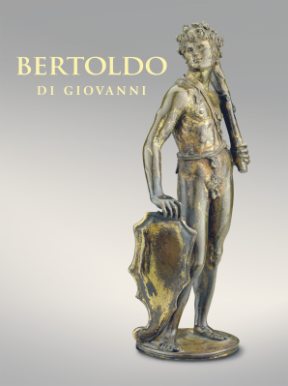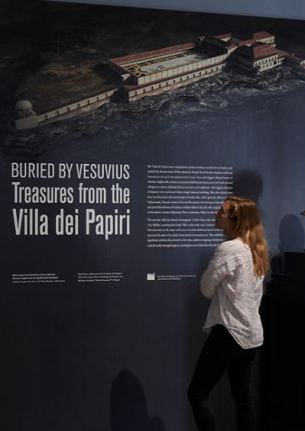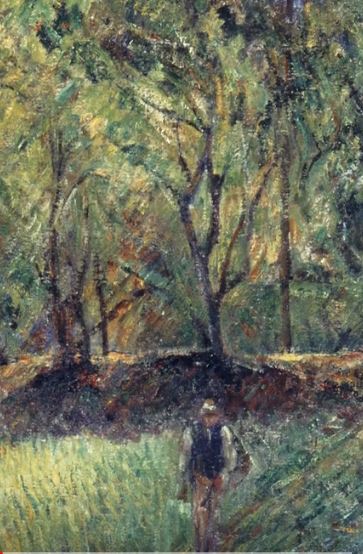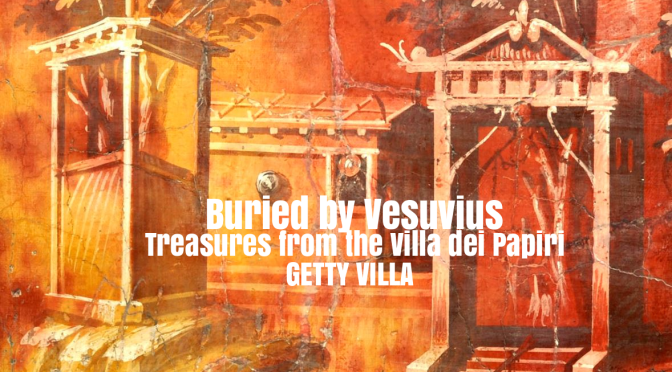 This fall, The Frick Collection will present the first-ever exhibition on the Florentine sculptor Bertoldo di Giovanni (ca. 1440–1491), a renowned student of Donatello, a teacher of Michelangelo, and a great favorite of Lorenzo “il Magnifico” de’ Medici, his principal patron. More than twenty statues, reliefs, medals, and statuettes — constituting nearly his entire extant oeuvre — will be on view exclusively at the Frick, which houses the only sculptural figure by Bertoldo outside of Europe. The exhibition will
This fall, The Frick Collection will present the first-ever exhibition on the Florentine sculptor Bertoldo di Giovanni (ca. 1440–1491), a renowned student of Donatello, a teacher of Michelangelo, and a great favorite of Lorenzo “il Magnifico” de’ Medici, his principal patron. More than twenty statues, reliefs, medals, and statuettes — constituting nearly his entire extant oeuvre — will be on view exclusively at the Frick, which houses the only sculptural figure by Bertoldo outside of Europe. The exhibition will highlight the ingenuity of the artist’s designs across media, including bronze, wood, and terracotta, and provide the first chance to fully explore longstanding questions of attribution, function, groupings, and intended display. Bertoldo di Giovanni: The Renaissance of Sculpture in Medici Florence will bring into focus the sculptor’s unique position at the heart of the artistic and political landscape in fifteenth-century Italy.
highlight the ingenuity of the artist’s designs across media, including bronze, wood, and terracotta, and provide the first chance to fully explore longstanding questions of attribution, function, groupings, and intended display. Bertoldo di Giovanni: The Renaissance of Sculpture in Medici Florence will bring into focus the sculptor’s unique position at the heart of the artistic and political landscape in fifteenth-century Italy.
Tag Archives: Exhibitions
Top Exhibitions: William Blake At Tate Britain (Sept. 11, 2019 to Feb. 2, 2020)
From a Tate Britain online description:
 Although Blake was considered mad by contemporaries for his idiosyncratic views, he is held in high regard by later critics for his expressiveness and creativity, and for the philosophical and mystical undercurrents within his work. His paintings and poetry have been characterised as part of the Romantic movement and as “Pre-Romantic”. A committed Christian who was hostile to the Church of England (indeed, to almost all forms of organised religion), Blake was influenced by the ideals and ambitions of the French and American Revolutions.
Although Blake was considered mad by contemporaries for his idiosyncratic views, he is held in high regard by later critics for his expressiveness and creativity, and for the philosophical and mystical undercurrents within his work. His paintings and poetry have been characterised as part of the Romantic movement and as “Pre-Romantic”. A committed Christian who was hostile to the Church of England (indeed, to almost all forms of organised religion), Blake was influenced by the ideals and ambitions of the French and American Revolutions.
William Blake (28 November 1757 – 12 August 1827) was an English poet, painter, and printmaker. Largely unrecognised during his lifetime, Blake is now considered a seminal figure in the history of the poetry and visual arts of the Romantic Age. What he called his prophetic works were said by 20th-century critic Northrop Frye to form “what is in proportion to its merits the least read body of poetry in the English language”. His visual artistry led 21st-century critic Jonathan Jones to proclaim him “far and away the greatest artist Britain has ever produced”. In 2002, Blake was placed at number 38 in the BBC’s poll of the 100 Greatest Britons.
To read more: https://www.tate.org.uk/art/artists/william-blake-39
World’s Top Exhibitions: “The Deep Listener” By Danish Artist Jakob Kudsk Steensen, Serpentine Galleries, London (2019)
 Designed as an augmented reality and spatial audio work downloadable as an app for mobile devices, it is both a site specific public artwork and a digital archive of these species, using tools and platforms from a range of fields including video games, computer generated images and film. Inspired by ecological science-fiction and scientific research, Kudsk Steensen creates a form of ‘slow media’ that uses the technological to foster attention rather than distraction.
Designed as an augmented reality and spatial audio work downloadable as an app for mobile devices, it is both a site specific public artwork and a digital archive of these species, using tools and platforms from a range of fields including video games, computer generated images and film. Inspired by ecological science-fiction and scientific research, Kudsk Steensen creates a form of ‘slow media’ that uses the technological to foster attention rather than distraction.
...a journey to both see and hear five of London’s species: London plane trees, bats, parakeets, azure blue damselflies and reedbeds.
Kudsk Steensen has collaborated with the field recordist and sound designer Matt McCorkle to represent five species as sound. The audio and visuals within the project are drawn directly from organic source material gathered from a period of embedded research within Kensington Gardens and Hyde Park. These organic materials are then transformed through digital processes to be re-embedded within the same context.
Download brochure: https://www.serpentinegalleries.org/files/press-releases/the_deep_listener_tdl_a5_digital_v2_final.pdf
Website: https://www.serpentinegalleries.org/exhibitions-events/serpentine-augmented-architecture
Top Museum Exhibitions: “Gorham Silver – Designing Brilliance 1850–1970” At The Rhode Island School Of Design
From a RISD Museum online exhibit:
 Established in 1831, the Gorham Manufacturing Company adeptly coupled art and industry, rising to become an industry leader of stylistic and technological achievement in America and around the world. It produced public presentation pieces and one-of-a-kind showstoppers for important occasions, as well as tableware for everyday use. Its works trace a narrative arc not only of great design but also of American ambitions. In this volume, insightful essays are accompanied by gorgeous new photography of splendid silver pieces along with a wealth of archival images, design drawings, casting patterns, and company records that reveal a rich heritage of a giant in decorative arts and silver manufacturing.
Established in 1831, the Gorham Manufacturing Company adeptly coupled art and industry, rising to become an industry leader of stylistic and technological achievement in America and around the world. It produced public presentation pieces and one-of-a-kind showstoppers for important occasions, as well as tableware for everyday use. Its works trace a narrative arc not only of great design but also of American ambitions. In this volume, insightful essays are accompanied by gorgeous new photography of splendid silver pieces along with a wealth of archival images, design drawings, casting patterns, and company records that reveal a rich heritage of a giant in decorative arts and silver manufacturing.
Produced in collaboration with the RISD Museum, which has the world’s most significant collection of Gorham silver, this major new book casts new light on more than 120 years of grand aesthetic styles in silver, innovative industrial practices, and American social and cultural norms.
Top Art Exhibitions: “The Impressionist Pastel” At Art Institute Of Chicago
From Art Institute of Chicago online release:
 This focused installation features pastels by four artists whose work was shown in the Impressionist exhibitions: Mary Cassatt, Edgar Degas, Eva Gonzalès, and Berthe Morisot. Their subjects range from scenes of modern life, such as ballet performers and a woman working in a hat shop, to depictions of intimate moments of bathing and women with children.
This focused installation features pastels by four artists whose work was shown in the Impressionist exhibitions: Mary Cassatt, Edgar Degas, Eva Gonzalès, and Berthe Morisot. Their subjects range from scenes of modern life, such as ballet performers and a woman working in a hat shop, to depictions of intimate moments of bathing and women with children.
Although Impressionism is most closely associated with oil painting, during the late 19th century, Impressionist artists increasingly began to exhibit and market their prints and drawings as finished works of art. In fact, prints and drawings made up nearly half of the works in the eight Impressionist exhibitions held in Paris between 1874 and 1886. Pastels in particular became increasingly sought-after by collectors.
 Pastel, a medium used to draw on paper or, less often, on canvas, is made by combining dry pigment with a sticky binder. Once artists have applied the pastel to the surface, they can either blend it, leave their markings visible, or layer different colors to create texture and tone. Pastel portraits had previously gained popularity in France and England in the 18th century, but fell out of fashion with critics when pastel was deemed too feminine; not only was it used by women artists, but it had a powdery consistency similar to women’s makeup. The Impressionists rejected this bias and instead embraced the medium’s ability to impart immediacy, boldness, and radiance.
Pastel, a medium used to draw on paper or, less often, on canvas, is made by combining dry pigment with a sticky binder. Once artists have applied the pastel to the surface, they can either blend it, leave their markings visible, or layer different colors to create texture and tone. Pastel portraits had previously gained popularity in France and England in the 18th century, but fell out of fashion with critics when pastel was deemed too feminine; not only was it used by women artists, but it had a powdery consistency similar to women’s makeup. The Impressionists rejected this bias and instead embraced the medium’s ability to impart immediacy, boldness, and radiance.
Website: https://www.artic.edu/exhibitions/9400/the-impressionist-pastel
Top Upcoming Exhibitions: “James Tissot – Fashion & Faith”, Legion Of Honor Museum In San Francisco Oct 12, 2019 To Feb 9, 2020
 Tissot consistently defied convention in both his professional and personal life. His contributions to the academy and the avant-garde are documented by participation at diverse venues such as the Paris Salon as well as London’s Royal Academy and the Grosvenor and Dudley Galleries. This exhibition explores his multifaceted career with a fresh perspective and original scholarship and will also question where and how Tissot should be situated in narratives of the nineteenth-century canon.
Tissot consistently defied convention in both his professional and personal life. His contributions to the academy and the avant-garde are documented by participation at diverse venues such as the Paris Salon as well as London’s Royal Academy and the Grosvenor and Dudley Galleries. This exhibition explores his multifaceted career with a fresh perspective and original scholarship and will also question where and how Tissot should be situated in narratives of the nineteenth-century canon.
Tissot was arguably a painter of modern life although he did not formally belong to the Impressionist circle and never exhibited in their group shows, despite an invitation from Edgar Degas.

The Fine Arts Museums of San Francisco and the Musée d’Orsay, Paris are co-organizing James Tissot: Fashion & Faith, the first major reassessment of the artist’s career in over 20 years. In San Francisco, this international retrospective will examine approximately 60 paintings, additional works on paper, and cloisonné enamels by Tissot. Exhibition highlights are drawn from the permanent collections of the Fine Arts Museums of San Francisco, including Tissot’s Self Portrait (ca. 1865) as well as prints and photographs from the Achenbach Foundation for Graphic Arts. New scholarship on the artist presented in this collaboration demonstrates that even Tissot’s most ebullient society paintings reveal rich and complex commentary on topics such as nineteenth-century society, religion, fashion, and politics, rendering him an artist worthy of reexamination in the twenty-first century.
https://legionofhonor.famsf.org/exhibitions/james-tissot-fashion-faith
Top Museum Exhibits: “STRANGE LIGHT: THE PHOTOGRAPHY OF CLARENCE JOHN LAUGHLIN” At High Museum Of Art, Atlanta
From the High.org website:
 Dubbed “The Father of American Surrealism,” Clarence John Laughlin (American, 1905-1985) was the most important Southern photographer of his time and a singular figure within the burgeoning American school of photography. Known primarily for his atmospheric depictions of decaying antebellum architecture that proliferated his hometown of New Orleans, Laughlin approached photography with a romantic, experimental eye that diverged heavily from his peers who championed realism and social documentary.
Dubbed “The Father of American Surrealism,” Clarence John Laughlin (American, 1905-1985) was the most important Southern photographer of his time and a singular figure within the burgeoning American school of photography. Known primarily for his atmospheric depictions of decaying antebellum architecture that proliferated his hometown of New Orleans, Laughlin approached photography with a romantic, experimental eye that diverged heavily from his peers who championed realism and social documentary.

On view through November 10, 2019
 The exhibition surveys Laughlin’s signature bodies of work made between 1935 and 1965, emphasizing his inventiveness, artistic influences, and deep connection to the written word. The High began collecting Laughlin’s work in 1974 and Strange Light: The Photography of Clarence John Laughlin is the first major presentation of Laughlin’s photographs by the High Museum following a landmark acquisition of his work in 2015.
The exhibition surveys Laughlin’s signature bodies of work made between 1935 and 1965, emphasizing his inventiveness, artistic influences, and deep connection to the written word. The High began collecting Laughlin’s work in 1974 and Strange Light: The Photography of Clarence John Laughlin is the first major presentation of Laughlin’s photographs by the High Museum following a landmark acquisition of his work in 2015.
The more than one hundred works in this exhibition attest to Laughlin’s innovative approach and prescience for the future of the photographic medium. From allegorical social commentary, to expertly constructed narratives, to bizarre material experimentation, Laughlin’s effort to access a higher artistic potential for photography is evident throughout his career. His desire to push the limits of photographic possibility paved the way for generations of artists and the growth of the medium into a tool of magical potential.
https://high.org/exhibition/strange-light-the-photography-of-clarence-john-laughlin/
Top Museum Exhibits: “Buried by Vesuvius – Treasures from the Villa dei Papiri” At Getty Villa
From a Wall Street Journal article:
 …the Getty Villa, despite some anomalies and insertions, is considered a strong likeness, which makes it a powerful locale for “Buried by Vesuvius: Treasures From the Villa dei Papiri,” the first major exhibition of works discovered in the Roman residence. The show includes Weber’s 1758 architectural map—used to build the Getty Villa—along with some of the approximately 90 sculptures pulled from the site, showing athletes, philosophers, rulers, poets and mythological figures. The exhibition also displays findings from the recent excavations.
…the Getty Villa, despite some anomalies and insertions, is considered a strong likeness, which makes it a powerful locale for “Buried by Vesuvius: Treasures From the Villa dei Papiri,” the first major exhibition of works discovered in the Roman residence. The show includes Weber’s 1758 architectural map—used to build the Getty Villa—along with some of the approximately 90 sculptures pulled from the site, showing athletes, philosophers, rulers, poets and mythological figures. The exhibition also displays findings from the recent excavations.
The idea was half-mad: building a museum to look like an ancient Roman villa that was buried under 75 feet of debris when Vesuvius erupted in A.D. 79 and had never really been seen since. But J. Paul Getty made his immense fortune by bringing ancient subterranean material (i.e. oil) to the surface, so he must have felt similar excitement in exhuming this villa, in concept if not reality. It opened as the home for his eponymous museum in 1974; now called the Getty Villa, and located in Los Angeles, it holds the institution’s Classical collections.
Top Museum Exhibits: “Paul Gauguin – The Art Of Invention” At The St. Louis Art Museum (Until Sept. 15)
From an Antiques and the Arts Weekly:
 Comprising 55 Gauguin masterworks on loan from Copenhagen’s Ny Carlsberg Glyptotek, as well as some 35 objects from the collection of the Saint Louis Art Museum, “Paul Gauguin: The Art of Invention,” now on view in St Louis, offers a superb overview and deep insight into the life, thought and art of this quasi-mythological being whose shadow looms large not only over artistic Modernism but over the very romantic notion of the artist who sacrifices everything for art.
Comprising 55 Gauguin masterworks on loan from Copenhagen’s Ny Carlsberg Glyptotek, as well as some 35 objects from the collection of the Saint Louis Art Museum, “Paul Gauguin: The Art of Invention,” now on view in St Louis, offers a superb overview and deep insight into the life, thought and art of this quasi-mythological being whose shadow looms large not only over artistic Modernism but over the very romantic notion of the artist who sacrifices everything for art.
Along with many other artists in every discipline, Gauguin has been reappraised in recent years. His freedom and devotion to art above all came at a steep cost to others: the wife and children he left behind in Europe, the Native child brides he took in the South Seas and the children they bore him and hosts of friends – Van Gogh and Pissarro among them – who felt the sting of his wrathful restlessness.
French art historian Jean Leymarie, in his short, perfect essay on Paul Gauguin, published in the gorgeous dusty columns of the 1962 Encyclopedia of Art, sums up the birth of Modernism: “Painters no longer attempted to represent the external world by creating the illusion of an image, but rather to suggest their interior dreams through allusive symbols and the multiplication of decorative forms; line and color were invested with the role of expressive vehicles and became the abstract equivalents of sensation. This change, amounting to the overthrow of the empirical and optical vision that had come down from the Renaissance, was perhaps the most violent about-face in modern art. The way, from that time, was open, and we know how boldly Gauguin proceeded.”
https://www.antiquesandthearts.com/the-right-to-dare-everything-paul-gauguin-the-art-of-invention/
Top Exhibitions: “N.C. Wyeth – New Perspectives” At Brandywine River Museum, Chadds Ford, PA
From a Wall Street Journal article by Edward Rothstein:
 In some cases, Wyeth’s images bore into memory as sharply as the books they illuminate. I’m thankful I never saw Wyeth’s “Captain Nemo” (1918) while steeping myself in Jules Verne’s “The Mysterious Island” (1874): I would never have been able to shed the image Wyeth created of this white-haired, secretive, dying man, surrounded by allusions to his exotic past, his skin seeming bleached, we learn here, by the electrical lighting of his submarine.
In some cases, Wyeth’s images bore into memory as sharply as the books they illuminate. I’m thankful I never saw Wyeth’s “Captain Nemo” (1918) while steeping myself in Jules Verne’s “The Mysterious Island” (1874): I would never have been able to shed the image Wyeth created of this white-haired, secretive, dying man, surrounded by allusions to his exotic past, his skin seeming bleached, we learn here, by the electrical lighting of his submarine.
This is the first retrospective Wyeth has received in a generation, and it may be unfair to begin an account of it with the illustrations that made him a commercial success, for they also haunted him as he struggled to free himself from his reputation as an illustrator— a struggle that ultimately involved his relationship with his more
artistically celebrated son, Andrew, and his attempts to both accommodate and bypass modernist taste. But you can see how they could have had that impact. This show—jointly created with Maine’s Portland Museum of Art, and curated by Christine B. Podmaniczky from the Brandywine and Jessica May from the Portland—pays tribute
to the illustrations’ power and notes, too, that Wyeth often cut his artistic cloth to suit the demands of magazine editors, advertising agencies and bank-building mural planners.










